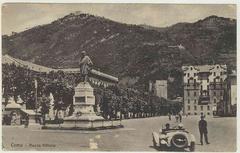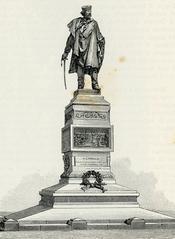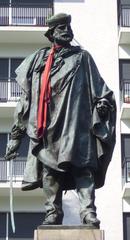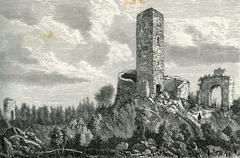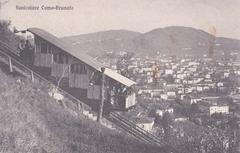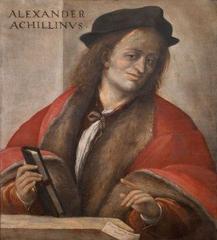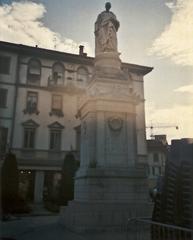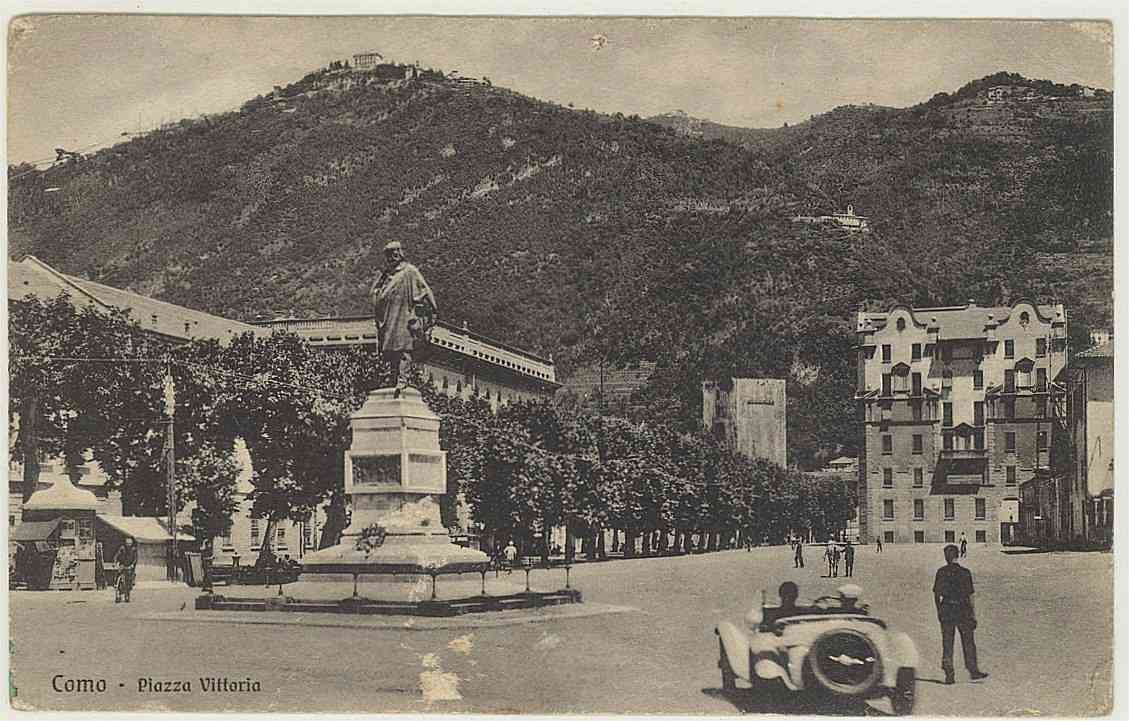
Visiting the Monument to Giuseppe Garibaldi in Como, Italy: Tickets, Hours, and Tips
Date: 14/06/2025
Introduction
The Monument to Giuseppe Garibaldi in Como is a landmark that embodies the spirit of Italian unification and the city’s deep-rooted civic pride. Erected in the heart of Como, this striking statue stands not only as a tribute to one of Italy’s most celebrated national heroes but also as a testament to the city’s pivotal role in the Risorgimento—the movement that led to the unification of Italy. Whether you are a history enthusiast, an art lover, or a curious traveler, this guide will provide comprehensive information on the monument’s history, artistic features, visiting hours, ticketing, accessibility, nearby attractions, and practical tips to help you plan your visit.
Historical Background
Origins and Historical Significance
The Monument to Giuseppe Garibaldi was inaugurated in 1909 in Piazza Vittoria, one of Como’s central squares, on the very site where Austrian forces were expelled after the decisive Battle of San Fermo in 1859. The monument replaced an earlier statue of Francis I of Austria, symbolizing Como’s transition from foreign rule to national unity. Created by the renowned sculptor Vincenzo Vela, the monument pays homage to Garibaldi’s leadership in the fight for Italian independence (VisitComo.eu, ComoCity.it).
Garibaldi and the Battle of San Fermo
Giuseppe Garibaldi (1807–1882), often called the “Hero of the Two Worlds,” led his volunteer forces, the “Cacciatori delle Alpi,” to a crucial victory at the Battle of San Fermo on May 27, 1859. This victory forced Austrian troops from Como, allowing the city to join the unification movement. Garibaldi’s military successes and charismatic leadership inspired widespread support and contributed significantly to the creation of a united Italy (DiscoverWalks.com, GetReadyForRome.com, Wikipedia: Garibaldi Museum (Como)).
Como in the Risorgimento
Como was a hub of revolutionary activity during the Risorgimento. The city’s citizens participated in significant uprisings, including the “Five Days of Como” in 1848, and rallied behind Garibaldi’s cause when he arrived in 1859 (GetReadyForRome.com).
Artistic and Symbolic Features
Vincenzo Vela’s design presents Garibaldi in a realistic and dignified style. The statue captures Garibaldi’s leadership and the broader ideals of liberty and unity. The bronze figure stands atop a tall granite pedestal with the simple inscription “A GARIBALDI,” emphasizing both the man and his cause. This style marked a shift in Italian public monuments toward personal connection and psychological depth (VisitComo.eu, Wikipedia: Vincenzo Vela).
The Garibaldi Museum
Adjacent to the monument, the Giuseppe Garibaldi Historical Museum, housed in the 15th-century Palazzo Olginati, offers collections of artifacts, uniforms, and documents related to Garibaldi and Como’s role in the Risorgimento. The museum, established in 1932, is a key resource for those seeking a deeper understanding of the era (Wikipedia: Garibaldi Museum (Como)).
Garibaldi’s National Legacy
Garibaldi’s influence extended throughout Italy, most notably through his leadership of the 1860 Expedition of the Thousand, which unified southern Italy with the north. His legacy is celebrated nationwide with monuments and museums, and he remains a symbol of sacrifice and unity (DiscoverWalks.com, GetReadyForRome.com).
Visiting the Monument to Giuseppe Garibaldi
Location
The monument stands in Piazza Vittoria, a central and lively square in Como. The piazza is a natural gathering place, surrounded by neoclassical and 19th-century buildings, cafés, shops, and is within easy reach of major attractions like the Cathedral, lakeside promenade, and historic city walls (The Tourist Checklist, PlanetWare).
Hours and Admission
- Monument: Open 24 hours a day, year-round. No ticket or reservation required.
- Garibaldi Museum: Typically open Tuesday through Sunday, 10:00 AM to 6:00 PM. Check official sources for variations and holiday closures.
- Admission Fees: Visiting the monument is free. Museum tickets are usually around €5, with discounts for seniors, students, and groups.
Accessibility
The monument is in a pedestrian-friendly square with smooth pavements and ramps, making it accessible for wheelchairs and strollers. The museum also provides accommodations for visitors with mobility needs, but it is best to confirm in advance if you require specific assistance.
Getting There
- By Foot: Easily reached from the historic city center and other attractions.
- By Public Transport: Local buses stop nearby; the Como San Giovanni railway station is about a 15-minute walk away (Beyond Yellow Brick Blog).
- By Car: Several parking garages are within a short walk, including Parcheggio Valduce and Parcheggio Lungo Lario Trento.
Things to Do Nearby
- Como Cathedral (Duomo di Como): A masterpiece of Gothic and Renaissance architecture.
- Museo Storico Giuseppe Garibaldi: For a deeper dive into Risorgimento history.
- Basilica of San Fedele: A Romanesque church near the city center.
- Piazza Cavour: The main lakeside square, great for strolls and boat tours.
- Teatro Sociale: An 18th-century theater hosting performances and concerts.
- City Walls and Waterfront: Scenic walks and photo opportunities (She Wanders Abroad, GPSmyCity Walking Tour).
Tips for Visitors
- Best Time to Visit: Spring and early autumn offer milder weather and fewer crowds. Early mornings and late afternoons provide the best light for photography.
- Special Events: The monument is a focal point for ceremonies on national holidays, including Republic Day (June 2) and the anniversary of the Battle of San Fermo (May 27).
- Photography: The statue’s elevated position and open surroundings allow for great photos from various angles, especially during golden hour or when illuminated at night.
- Amenities: Cafés, shops, and public restrooms are available in the area. Many venues offer free Wi-Fi. Como is a safe city, but standard travel precautions apply.
Guided Tours and Educational Experiences
Sustainability and Responsible Tourism
Respect the monument and its surroundings by disposing of litter properly, minimizing noise, and refraining from climbing on the statue or pedestal. Supporting local businesses and museums helps preserve the city’s cultural heritage for future generations.
Frequently Asked Questions (FAQ)
Q: What are the visiting hours for the Monument to Giuseppe Garibaldi in Como?
A: The monument is located outdoors in a public square and is accessible 24/7. The Garibaldi Museum is open Tuesday to Sunday, 10:00 AM to 6:00 PM.
Q: Is there an admission fee?
A: No, visiting the monument is free. The museum charges a modest entry fee.
Q: Are guided tours available?
A: Yes, many walking tours of Como include the monument and the museum. Booking is available via local tourism offices or online.
Q: Is the area wheelchair accessible?
A: Yes, the square and museum are accessible, though some cobblestones may be uneven.
Q: What are the best nearby attractions?
A: The Como Cathedral, Broletto, lakeside promenade, Museo Storico Giuseppe Garibaldi, and the city’s medieval walls.
Q: How do I get to the monument from the train station?
A: It’s a 15-minute walk from Como San Giovanni station, or you can take a bus or taxi.
Q: When are the busiest and quietest times?
A: Peak crowds occur from May to September and during holidays. Early mornings and late afternoons are quieter.
Visuals and Interactive Elements
- High-quality images of the monument and surrounding piazza at different times of day.
- Photos of nearby attractions and city streets.
- An interactive map showing the monument’s location in relation to Como San Giovanni station and other points of interest.
- Links to virtual or guided tours if available.
Conclusion
The Monument to Giuseppe Garibaldi in Como is more than a historical landmark; it is a living symbol of unity, courage, and civic pride. Its central location, free and easy access, and proximity to major attractions make it an essential stop on any Como itinerary. Pair your visit with the nearby museum and take time to explore the surrounding squares, cathedrals, and lakefront for a rich and memorable experience.
Call to Action
For up-to-date travel tips, guided tour options, and exclusive content on Como’s historical sites, download the Audiala app. Follow us on social media and explore our related articles for more inspiration and practical advice as you plan your visit to Italy’s Lake Como region.
